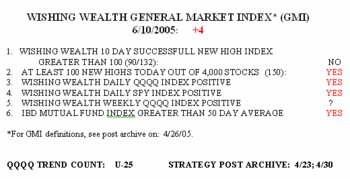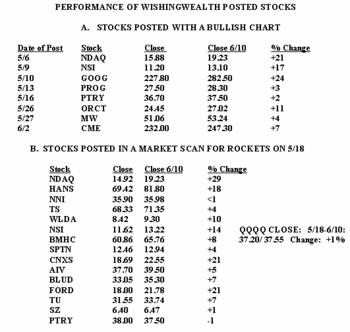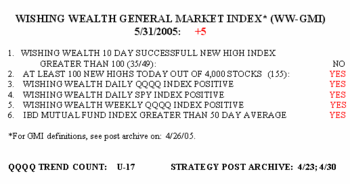To my visitors: I am only one trader, not a guru, and not a financial advisor. I am presenting my own opinions and my own experiences and people are welcome to decide for themselves what, if anything, on this site is of value to them. Please refer to the additional comments, highlighted in red, at the end of this post.
The GMI lost another point today, to +4. The Weekly QQQQ Index dropped below positive and is too close to call. If I strictly follow my rules, then it is a negative. This does not mean that the up trend is over, as long as the QQQQ Daily Index remains positive. We are in the 25th day of the up trend and some prior up trends have gone into triple digits before the index turns negative. The 10 day successful new high index is barely negative, at 90, and given that we had well over 100 daily new highs every day in the past 2 weeks, this index has a good chance of turning positive again. (It measures the number of stocks hitting new highs 10 days ago that closed today higher than their close on that day, see archive post–4/26). New highs in my universe of 4,000 stocks totaled 150, with only 25 new lows. In spite of this strength, only 17% of the Nasdaq 100 stocks advanced on Friday (the least since June 5), 39% of the S&P 500 stocks and 43% of the Dow 30. The QQQQ remains below its 10 day average, and I will start becoming defensive with a CLOSE below 37. On the other hand, a bounce at 37 would cause me to get bullish.
The Weekly QQQQ Index dropped below positive and is too close to call. If I strictly follow my rules, then it is a negative. This does not mean that the up trend is over, as long as the QQQQ Daily Index remains positive. We are in the 25th day of the up trend and some prior up trends have gone into triple digits before the index turns negative. The 10 day successful new high index is barely negative, at 90, and given that we had well over 100 daily new highs every day in the past 2 weeks, this index has a good chance of turning positive again. (It measures the number of stocks hitting new highs 10 days ago that closed today higher than their close on that day, see archive post–4/26). New highs in my universe of 4,000 stocks totaled 150, with only 25 new lows. In spite of this strength, only 17% of the Nasdaq 100 stocks advanced on Friday (the least since June 5), 39% of the S&P 500 stocks and 43% of the Dow 30. The QQQQ remains below its 10 day average, and I will start becoming defensive with a CLOSE below 37. On the other hand, a bounce at 37 would cause me to get bullish.
A lot of my stocks are consolidating or are still advancing. I just relax and let my sell stop orders and put options (see yesterday’s post about using puts for insurance) watch the market for me. If I can hang on until the last week of June and the calendar quarter, I think they will close strong. I do expect some volatility through option expiration this week.
I have been writing this blog since mid April. I thought it would be informative for me to examine the performance of the stocks that I have been highlighting during this rally.  I computed two analyses. The first (Part A in the table–click on it to enlarge.) contains all stocks that I wrote about positively, with an accompanying chart. The second shows the performance of all of the stocks I published in a table containing the results of a scan of the market for potential rockets I did on May 18. (While, I checked my list and the computations, please let me know if you detect any errors or omissions.)
I computed two analyses. The first (Part A in the table–click on it to enlarge.) contains all stocks that I wrote about positively, with an accompanying chart. The second shows the performance of all of the stocks I published in a table containing the results of a scan of the market for potential rockets I did on May 18. (While, I checked my list and the computations, please let me know if you detect any errors or omissions.)
I was surprised by the results. All of the 8 stocks that I had posted as being bullish and for which I posted a chart (Part A) rose in the period since the original post and Friday’s close. GOOG and NDAQ did the best, climbing more than 20%. PROP and PTRY rose the least, 2-3%. Since the time (5/6-5/10) when I posted NDAQ, NSI and GOOG, the QQQQ rose between 4-5%, so these 3 stocks rose about 5 times more than the general Nasdaq tech stocks. The last 3 stocks listed (ORCT, MW, CME) actually rose during a period when the Nasdaq index-QQQQ, declined.
Part B shows the performance of the 15 stocks that survived a scan for rockets that I posted on 5/18. During this period, the QQQQ rose just 1%, but 13 of these stocks rose, 6 by more than 10%. If you want to know more about how I find rockets, check out my strategy posts in the archive on 4/23 and 4/30, and the scan on 5/18.
I am not showing you these results to receive your accolades or to recommend these stocks. I am trying to show you that someone with no accounting background and with limited understanding of the intricacies of the economy can use technical analysis along with tools like IBD, TC2005 and free internet research tools to select possible winners. Most important, one can do this while working full-time and without the need to be glued to a monitor all day. But you must do your homework first. In addition to reading this blog, you should check out www.thekirkreport.com daily to keep up on important business news and market topics. You should also read the writings of the successful stock market traders; most of the gurus who have really educated me are described in John Boik’s new book. In addition, you should read Stan Weinstein’s book to learn some simple technical charting techniques. (All I use is the very simplest tools.)………………………………………..
I am becoming accustomed to writing this blog–my first post was on 4/17. I try to post by midnight during trading days. During the weekend I have more time to reflect on the market and to write. I read all of your emails and greatly appreciate them, but I often must wait until the weekend to reply. (If I ever fail to respond, please remind me.) Writing this blog has actually helped my trading performance. It has helped me to systematize my rules and to have the discipline to follow them–thank you. My largest losses have occurred when I have deviated from my rules. Keep sending me your questions and comments. Send your feedback to silentknight@wishingwealthblog.com.
Please remember that the stock market is a risky place, especially now. I am not providing recommendations for you to follow. My goal is to share tools and methods that I have used over the past 40 years of trading, so that you may learn from them and adapt them to your trading style and needs. While I do my best, I do not guarantee the accuracy of any statistics computed or any resources linked to my blog. Please consult with your financial adviser and a mental health practitioner before you enter the stock market, and please do not take unaffordable risks in the current market environment. See the About section for more statements designed to protect you (and me) as you navigate this market. Past performance does not guarantee future results, but I would rather learn from a former winner than a loser.
